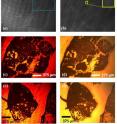Microscope on the go: Cheap, portable, dual-mode microscope uses holograms, not lenses
Related images
(click to enlarge)
To serve remote areas of the world, doctors, nurses and field workers need equipment that is portable, versatile, and relatively inexpensive. Now researchers at the University of California at Los Angeles (UCLA) have built a compact, light-weight, dual-mode microscope that uses holograms instead of lenses. The team describes the new device in a paper published August 30 in the Optical Society's (OSA) open-access journal Biomedical Optics Express. Their prototype weighs about as much as a medium-sized banana and fits in the palm of a hand. And, since it relies in part on mass-produced consumer electronics, all the materials to make it add up to between $50 and $100 USD.
It also has a two-in-one feature: a transmission mode that can be used to probe relatively large volumes of blood or water, and a reflection mode that can image denser, opaque samples. The spatial resolution for both modes is less than two micrometers -- comparable to that achieved by bulkier microscopes with low- to medium-power lenses.
"This is the first demonstration of essentially a hand-held version of a microscope that can do dual-mode imaging within a very compact and cost-effective form," says Aydogan Ozcan, an associate professor of electrical engineering and bioengineering at UCLA and senior author of the paper.
With just a small amount of training, doctors could use devices like these to improve health care in remote areas of the world with little access to diagnostic equipment, Ozcan says. The handheld microscope could help ensure water quality, test patients' blood for harmful bacteria, and even be used for semen-quality monitoring on animal farms.
It could also prove useful in health crises such as the recent outbreak of E. coli in Europe.
"It's a very challenging task to detect E. coli in low concentrations in water and food," Ozcan says. "This microscope could be part of a solution for field investigation of water, or food, or maybe pathogens in blood."
Part of the device's success is the weight it shed when researchers got rid of the bulkier, heavier, more expensive pieces that most microscopes rely on for collecting and focusing light: the lenses. Instead of lenses, this microscope uses holograms.
Holograms are formed when light bouncing off (or passing through) a three-dimensional object is made to interfere with a "reference beam," or light that has not hit the object. Consider this analogy: drop a stone into a still pond and the ripples will move outward in a circle. Drop two stones and the circular ripples will interfere with each other, making a new pattern of crests and troughs. A person (or computer) analyzing the interference pattern created by those two stones could trace the source back to the stones and recreate what had happened to make the waves.
The UCLA team's device uses a similar principle to recreate images from interfering light waves.
An inexpensive light source is divided into two beams -- one that interacts with microscopic cells or particles in the sample, and the other that does not. The beams then pass to an adjacent sensor chip, where their interference pattern is recorded.
Software then analyzes that pattern and recreates the path taken by the light that passed through or bounced off of the objects being imaged.
Each component of the device is fairly inexpensive, Ozcan says. The laser light could come from a $5 laser pointer. The sensor chip that collects that light is the same as the ones in the backs of iPhones and Blackberrys and costs less than $15 per chip. And the whole image-collecting system runs on two AA batteries.
Where the researchers have reduced weight and expense in doing away with lenses, they have added the power of the cloud. The microscope captures raw data; but a computer is required to reconstruct the images. Workers in the field could use their laptops to process the information or send it over the Internet or mobile phone networks to a remote server. Mobile phones could also have sufficient processing power to do the analysis on the spot.
Essentially, Ozcan says, "we are replacing an expensive and bulky, heavy component with computer codes."
The next steps for Ozcan's team include commercializing the device. Ozcan says he has founded a company that is developing this technology, trying to make a version of the microscopes that can be manufactured and sold to healthcare workers and hobbyists.
"Global health is a big field that requires better diagnostic tools, because resource-poor countries don't have the infrastructure for conducting essentially accurate diagnostic tests," Ozcan says. "There are so many problems that innovative solutions [like this microscope] would impact."
Source: Optical Society of America
Other sources
- Holographic Microscope Detects Bacteria on the Cheapfrom PopSciThu, 1 Sep 2011, 18:30:43 UTC
- Hologram microscope spots E. colifrom BBC News: Science & NatureThu, 1 Sep 2011, 12:01:11 UTC
- Microscope on the go: Cheap, portable, dual-mode microscope uses holograms, not lensesfrom Science DailyTue, 30 Aug 2011, 17:30:22 UTC
- Microscope on the go: Cheap, portable, dual-mode microscope uses holograms, not lensesfrom PhysorgTue, 30 Aug 2011, 16:01:05 UTC


